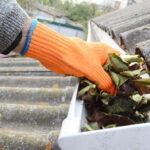Potatoes Grow in Bags at Project Spudnik
Thanks to the University of Maryland / Maryland Grows for this article about growing potatoes.

Container gardening is wildly popular these days. Type “grow potatoes in containers” and your search engine will return over 7 million web pages. Six years ago, Sherrill Munn, a UME Master Gardener in Calvert Co., developed a fun and challenging youth gardening program he named Project Spudnik. It was designed to encourage a love of gardening, teach environmental stewardship, and raise fresh produce for people in need. The project is a partnership between the All Saints Episcopal and Broadview Baptist Church Youth Groups and Calvert County Master Gardeners and is open to all youth in the county.
Project Spudnik is a mash-up of the movie “The Martian” and Sputnik, the first satellite in space. The movie depicts an astronaut stranded on Mars who must survive until a rescue can be attempted. To do so, he had to raise potatoes that had been taken to Mars as an experiment. Participants watch the movie and are then challenged to raise potatoes in grow bags. With Master Gardener guidance they make their own soil, as did the astronaut in the movie. If the teens are successful, they survive on Mars, if not they perished on Mars.
Growing Potatoes and more
In addition to potatoes, they plant and harvest tomatoes, potatoes, beans, peppers, eggplant, carrots, blueberries, cabbages, various greens, and flowers in approximately 100 fabric grow bags, ranging in size from 10-20 gallons. Youth learn how to use organic fertilizers and how to prevent nutrient runoff and ground and water pollution. They also learn about integrated pest management- how to prevent and manage pest and plant problems with the least environmental impact possible. Finally, they learn how to responsibly use water in gardening.
A pollinator garden was added last year as well as a drip irrigation system that helped double the yield of produce. Over 460 pounds of produce was donated to area food banks in 2019! The drip system uses water more efficiently, reducing waste and preventing runoff. There are 2020 plans to create a children’s garden, buy a shed and composter, and replace a decorative garden arch that was toppled in a 2019 storm.
Sherrill summed up the project’s value:
“At a time when too much learning is done via boring worksheets and interactions happen on social media, it is important to encourage kids to get their hands dirty with a project with tangible results. Further, gardening can teach important lessons in nutrition, biology, mathematics, social studies and geography.
The garden also teaches youth responsibility and leadership skills as they learn to take charge of the garden and their own grow bags. They will make the decisions on their bag’s soil composition, when to water, when and how much fertilizer to use and what to do if their plants are attacked by pests. If the garden produces food, it will be because of the youths’ hard work.
In addition to the benefits enjoyed by the youth participants, the hungry of Calvert County will benefit from receiving fresh, locally grown fruits and vegetables.”
Project Spudnik was recognized by the Governor’s Office of Service and Volunteerism as a 2019 “Honor Row” recipient. Youth and parent chaperones received tickets to a Raven’s game, received an award from the Governor’s office, and were featured on the jumbo-tron.

Potato growing tips from the Project Spudnik folks:
- Pick a sunny location (8 hours or more of sun).
- Use 12-gallon fabric grow bags, 16” deep by 16” diameter. Purchase them in garden centers or on-line. The come in many colors, shapes and sizes.
- Use a good lightweight commercial growing media (“potting mix”) or make your own (see recipe below). You will need about 1.5 cubic feet or around 12 dry gal per grow bag. Peat moss or coconut coir are the most high quality growing media. These materials repel water so thoroughly moisten the grow mix by working water in with your hands, prior to filling your bags.
- Purchase certified seed potatoes locally or online. You can plant them whole or cut into pieces that each have at least two buds (“eyes”). Place about 4” of container mix evenly across the bottom of the bag. Evenly space 3 to 5 seed potatoes and/or pieces (“eyes up”) and cover with 3 inches of growing media. Fertilize lightly with a complete organic fertilizer, following product directions.
- When the potatoes have grown halfway up the bag, about 8 inches, add about 4 inches of growing media and fertilize lightly again. It’s okay if some of the green stem and leaves are covered. When the plants are again about 8 inches above the new soil level, add another 4” of container mix and repeat this process until bag is full, leaving about an inch or inch and a half at top of bag as a water reservoir. (This process is very much like “hilling” potatoes that are planted in the ground.)
- The growing media should be kept moist throughout the fabric bag. Grow bags can dry out quickly, especially in wind and hot, dry weather- so check the moisture level often!
- Flea beetles, three lined potato beetles, and Colorado potato beetles are common insect pests. The latter two can be picked off.
- Potatoes let you know when they are ready to harvest; the plants will begin to turn yellow and the stems wilt and fall over. After another week or two, simply dump the contents of the grow bag into a wheelbarrow and pick out the potatoes. Discard the old container mix elsewhere in your yard or garden where needed If you want new potatoes, gently dig down into your grow bag after the potatoes have flowered and harvest a few; then replace the mix.
Potato yields
Regarding potato yields, Sherrill notes that “The bags vary in the amount of potatoes depending on how vigilant the youngster responsible for it is. They average around 3 lbs. We plant 4 seed potatoes or seed pieces per bag. Recommendations for the size of bag we use is to plant 3 to 5 seed potatoes. Larger bags would, of course, produce more potatoes. I use larger bags at home and produce 5 to 6 lbs. on average per bag.”
Sherrill’s Recipe for Container Mix (fills 8 ten-gallon fabric bags)
- 1 Part Sphagnum Peat Moss or Coconut Coir (4 Cu Ft)
- 1 Part Compost (leaf or yard waste) (4 Cu Ft)
- 1 Part Vermiculite or mix of Perlite & Vermiculite or Rice Hulls (4 Cu Ft)
- 0.5 Cu Ft Bag of Course Sand (for added weight)
- 12 lb. Bag of Worm Castings
- 6 cups of Dolomitic Lime- not for potato (grow best at 5.3-6.0 soil pH) or blueberry (grow best at 4.3-5.3 soil pH)
- Fertilizer added as needed.
By Jon Traunfeld, Director, Home & Garden Information Center.
Many thanks to Sherrill Munn for sharing the story and photos about growing potatoes.
Read other stories from University of Maryland, Home & Garden Information Center.








Recent Comments